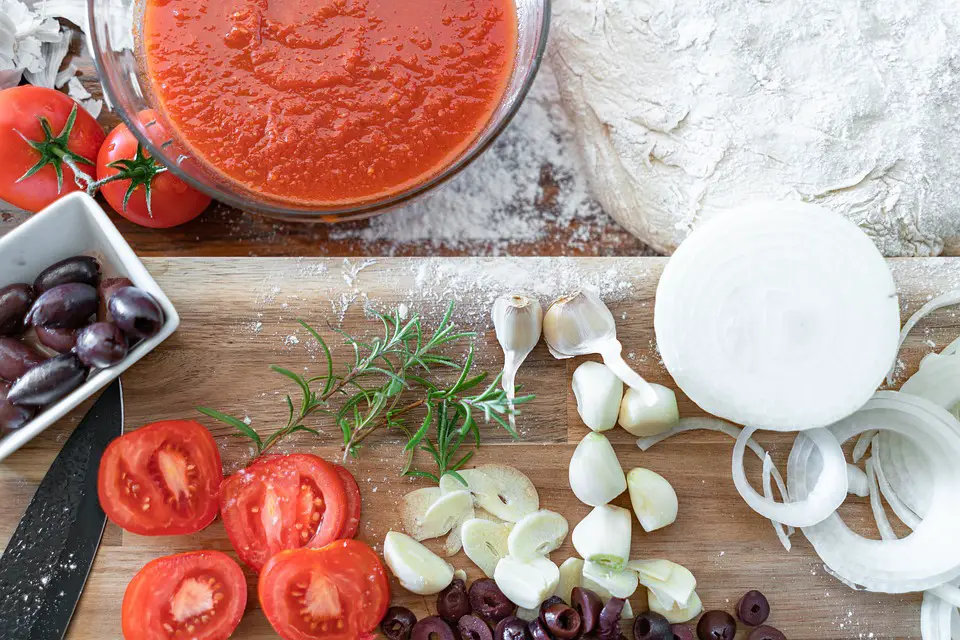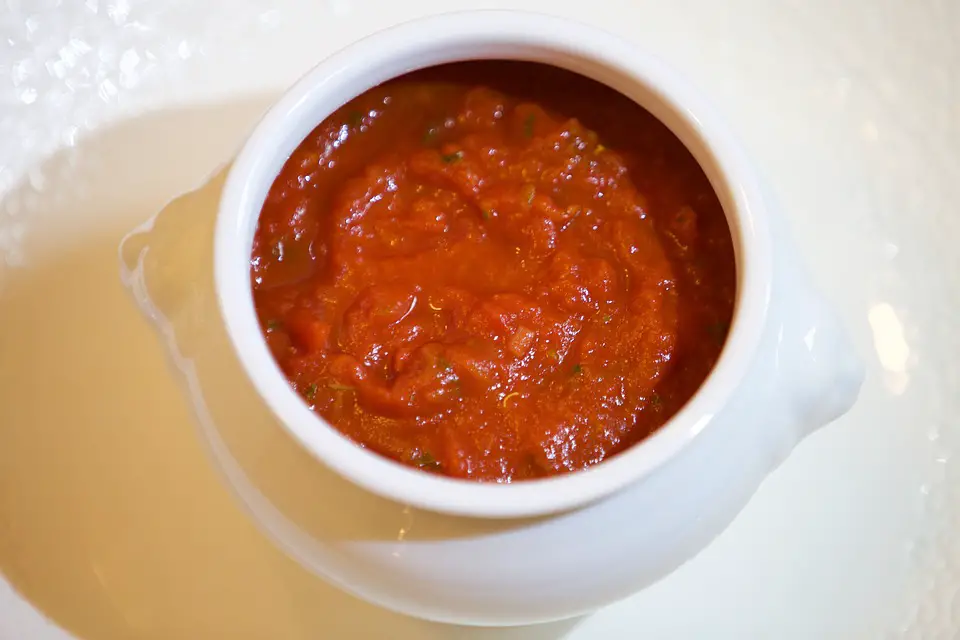It sounds simple enough, but after years of freezing my tomato paste, I’ve developed a superior technique. I used to stuff it into a freezer bag, press it to the bottom, and store it there. But when I wanted to use it again, it caused issues. How much tomato paste from a frozen clump should you measure? What if I only needed a portion of the clump to use? I would eventually tear off a piece, unaware of how much I was using.
This guide is intended for everyone who has been discarding their partially used tomato paste cans and has been spooning them into a freezer bag like I used to. Your leftover tomato paste should be used for this, and it’s as simple as 1-2-3.

What is Tomato Paste?
Simply put, tomato paste is concentrated tomato sauce. You can make tomato paste by boiling down tomatoes, straining out the skin and seeds, and then simmering the sauce until it thickens. Manufacturers of tomato paste occasionally add herbs, spices, salt (some versions without salt), and stabilizers such as citric acid.
There are now triple- and double-concentrated varieties of tomato paste, which increases their potency. If you want to make great, strongly flavorful meals, tomato paste is a pantry essential that you must always have on hand. Using it, you may make a basic recipe, like soup or sauce, into something very special.
Small 6-ounce cans of tomato paste are frequently used for sale because a little goes a long way. Even the smallest can of tomato paste is huge because most recipes only call for a tablespoon or two. The leftovers can always be frozen for later use or stored in the refrigerator (hopefully before they go bad) (read more on the best way to do this below).
Alternatively, going from tomato paste in a can to tomato paste in a tube would be better (maybe our favorite option). Here are some general tomato paste facts, reasons to buy it in a tube, and several recipes you might like to try.
How to Freeze Tomato Paste?
Prepare the Tomato Paste
On a plate or baking sheet wrapped in plastic wrap, drop dollops of your leftover tomato paste equal to 1 tablespoon over the surface. The tomato paste will be wrapped in plastic and placed inside a freezer bag to prevent it from clinging to the plate as it freezes. To ensure that the dollops freeze separately and are simple to divide into 1-teaspoon servings later, ensure they are not touching. Place the plate or baking sheet, uncovered, in the freezer for two to three hours or until the dollop is completely frozen.
Transfer the Tomato Paste
The tomato paste keeps its lumps better when frozen uncovered on a flat surface, but if you do it too long, it may dry out and develop freezer burn. TI used a freezer bag that was quart size and labeled it with the contents. Put the package inside the freezer bag after lifting the plastic wrap from the plate and wrapping it around the balls. The balls won’t fuze together if you merely wrap them in plastic because they are already frozen firm. To store them for a long time, you must move them to an airtight container as soon as they are solid.
Freeze for Long Term Storage
Before sealing, remove as much air from the bag as possible, then put it back in the freezer. Now, if you need some tomato paste for a recipe, grab one or more lumps! They keep well in the freezer because tomato paste naturally has a low moisture content. Since I use tomato paste frequently, I’ve never kept any in the freezer for more than 4-5 months, but up until that point, it’s always held its quality.
What are the Health Benefits of Tomato Paste?
Basics
Fresh tomatoes are simmered until they break down to make tomato paste. The skin and seeds are then removed and roasted for at least a few hours until their moisture is gone and they have turned into a thick paste. Normal seasonings include salt and olive oil, but some commercial items include extra seasonings and sweeteners such as high fructose corn syrup. There is enough tomato paste in one 6-ounce can make a pot of chili or stew that serves six people, or one ounce per serving. The nutritional information is given for one tablespoon, or around half of that quantity.
Lycopene
The finest natural source of lycopene, a potent antioxidant of the vitamin A family, is tomatoes. Although research has yielded conflicting findings, it frequently makes headlines for its ability to prevent prostate cancer, according to a review published in November 2011 in the “Cochrane Database of Systematic Reviews.” According to a study in the journal “NeurologyOctober “‘s 2012 issue, men who consumed more lycopene had a decreased risk of strokes. Lycopene consumption guidelines have not been defined, although consuming 4 to 8 mg daily is likely sufficient to have positive health effects. The amount of lycopene in 1 tablespoon of tomato paste is 4.6 milligrams.
Vitamin C
Although it generates neurotransmitters and collagen, which supports your skin and ligaments, vitamin C is better recognized as an antioxidant. Its antioxidant properties shield your body from free radical damage, including protecting the proteins and fats in your brain from oxidative damage. Your skin’s vitamin C content protects it from sun exposure’s negative effects. Women only need 75 milligrams of vitamin C daily, compared to 90 mg for men. For pregnant women, the recommended daily consumption rises to 80 milligrams. Smokers require an additional 35 mg every day. Vitamin C in one tablespoon of tomato paste is 3.5 milligrams.
Reference: Effect of the addition of tomato paste on the nutritional and sensory properties of mortadella
How to Recognize Bad Tomato Paste?
If you don’t store tomato paste in the refrigerator, it will spoil sooner, even though it can last for several months or even a year. Purchase no more than a few tablespoons at a time to preserve the paste’s quality. Make sure you only purchase tomato paste when essential to avoid overspending. Throw it out right away if something goes wrong.
Glass jars, tubes, and cans work well for storing tomato paste. The well must be covered to prevent mold growth and odors, and they must be kept out of direct sunlight in a calm, dry atmosphere. If in doubt, sample a few jars to learn what kind of paste is included.
Glass jars, cans, and even tubes can all be used to store tomato paste. Even though it is one of the most frequently used, tomato paste takes some time to ingest. When not opened, tomato paste has a six-month shelf life and is a basic component in practically all recipes. If kept in a cool, dry place, tomato paste can last for a few weeks. It’s important to watch for any surface stains or mold. It’s time to solve these issues if they exist.
Utilizing tomato paste before expiration is the greatest technique to evaluate its quality. It should be possible to use a pot with a few months left on its shelf, and if it has already been opened, it might still be useful after five to seven days. Tomato paste jars that haven’t been opened for several months won’t likely go bad, but they might once you’ve opened them.
How should I Keep Tomato Paste?
Cans, glass jars, and tubes are the three most common packaging options for tomato paste. Almost the same storage recommendations apply to each. Keep the container away from heat sources in a cool, dry area if it hasn’t been opened. A glass jar shouldn’t be exposed to direct sunlight, so keep that in mind. Tomato paste should be kept in a pantry or cabinet in the kitchen.
Ensure a radiator or oven is not next to the cabinet or shelf. When not in use, the tomato paste should be carefully covered after opening the container and kept in the fridge. Glass tubes or jars don’t provide a problem, but cans are more difficult to seal.
Cling wrap or a plastic bag secured with a rubber band are good options for sealing items. If any paste is left over, alternately pour it into a glass jar or another airtight container. Tomato paste doesn’t stay very long, as you are well aware. Thankfully, with some additional labor, we can extend its shelf life by several months.
What are the Uses for Tomato Paste?
There are numerous tasty uses for tomato paste. Want to make homemade tomato sauce easily? Do you want some creamy tomato soup and grilled cheese? Tomato paste is essential since it rapidly adds a tonne of tomato flavor.
Use tomato paste to enhance the flavor of other dishes and create tomato-heavy dishes like sauces and soups. We used this to make the dipping sauce for these Air-Fryer Zucchini Fries, Jackfruit Sloppy Joes, and Slow-Cooker Butter Chicken recipes.
Most likely, there is tomato paste in a tube or can in a cabinet waiting to be used. Of course, you’ll always include tomato paste on your grocery list even if you don’t plan to use it in a recipe because you never know when you’ll need it.
One of those essential ingredients, tomato paste, teaches chefs the building blocks of great sauce creation. Sophina Uong, chef and owner of Mister Mao in New Orleans says tomato paste is like the “little black dress” regarding ingredients. “You must keep it in your cupboard for that extra caramelized umami depth, sweetness, and velvety richness of color.
In addition, I believe tomato paste is a useful addition to many kitchens because of how much flavor it brings to a variety of recipes, says chef and culinary writer Marta Rivera Diaz of Sense and Edibility. An excellent illustration is how a small amount of tomato paste can replace large amounts of tomato sauce or fresh tomatoes, diluting the meal they are added to in dishes like chili, stews, or beans.
Conclusion
There are many ways to store your tomato paste, including freezing it in an airtight container, ice cube tray, or a freezer bag. Freezing tomato paste will prolong its shelf life. While tomato paste will lose some flavor when defrosted, it will still be safe to eat.
When freezing tomato paste, you should ensure it’s airtight and tightly sealed. This will prevent it from sticking to the bottom or causing freezer burns. You should also leave enough room at the top of the container to allow it to expand as it freezes. Be sure to line the freezer-safe container with cling wrap to prevent it from sticking to the bottom.
